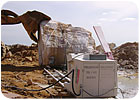
Kyanite Mining Corp. of Dillwyn, VA, which has been extracting the mineral kyanite mainly for refractory purposes, recently began quarrying dimensional blocks for residential and commercial design applications.
Divided into the Willis Mountain and the East Ridge deposits - just three kilometers from each other - these two quarries have steadily supplied the company’s core business of providing kyanite for the refractory industry, according to John Snoddy, Director of the Dimensional Stone Department. “Our traditional customer base is spread all over the world, and we’re the preeminent supplier,” he said of the refractory sector. In general, the “refractory industry” refers to heat-resistant materials that constitute the linings for high-temperature furnaces, kilns and reactors, and must be able to withstand high temperatures, chemical corrosion and provide thermal shock resistance. Kyanite is also used for products such as ceramics, investment casting shells, brake shoes and pads, electrical porcelains, sanitary ware, kiln furniture, electrical insulators and abrasives. In fact, kyanite was incorporated into the re-entry shields on America’s early space missions.
In the 1940s, the company employed less than 15 people and mined approximately 300 tons of ore per month. Today, the company’s two quarries and five processing plants employ 150 individuals in an operation that has the capacity to produce over 150,000 tons of commercial-grade kyanite concentrate a year.

The process of quarrying dimensional blocks of stone is supported by the Willis Mountain deposit - one of the two mountains the company owns.
Dimensional stone processing
In 2006, Kyanite Mining Corp. began a new chapter in its history when it began quarrying dimensional blocks of kyanite for commercial and residential applications. The process, supported by the Willis Mountain Quarry, produces the only dimensional stone products containing the mineral kyanite. These products have exceptional hardness and heat resistance due to the inherent properties of the mineral kyanite, the company reports.According to Snoddy, stone in the central Virginia deposit dates to the Pre-Cambrian age, and the material has been metamorphosed numerous times. “The weather-resistant kyanite quartzite is all that remains of the formerly dome-like exposure, now represented as the East Ridge and Willis Mountain quarries,” he said.
The stone can be extracted in all sizes and shapes using a Pellegrini diamond wire saw, which Snoddy explained slices the stone quickly and effectively. “When it comes to any stone shipped on the road or overseas, we’re not sending a lot of waste because we’re able to create a virtually perfect rectangle with this saw.”
Snoddy said that the average block measures 9 x 5 x 4 feet in size, but the sizes can be adjusted depending on a customer’s requests. Since blocks are only extracted when necessary, the amount of workers in the quarry also varies. “We don’t have dedicated dimensional stone workers,” said Snoddy. “Two [crew members] from our industrial quarry will remove blocks when required, but it’s not a full-time dimensional stone quarry yet. We’re only extracting blocks when we need them or when we’re replenishing our inventory. We do however, have the ability to create blocks at a moment’s notice, so customers don’t wait long for their requested material.”
The stone is available in silver, blue and red, with or without waves of maroon and rust - highlighted by kyanite crystals - giving it a unique appearance for residential applications. Potential uses for kyanite as a dimensional stone include kitchen, bar and vanity countertops and landscaping stone as well as staircases, fireplace surrounds and other architectural products. “Any dimensional or architectural use of stone is one that we’re interested in for our product,” Snoddy said.